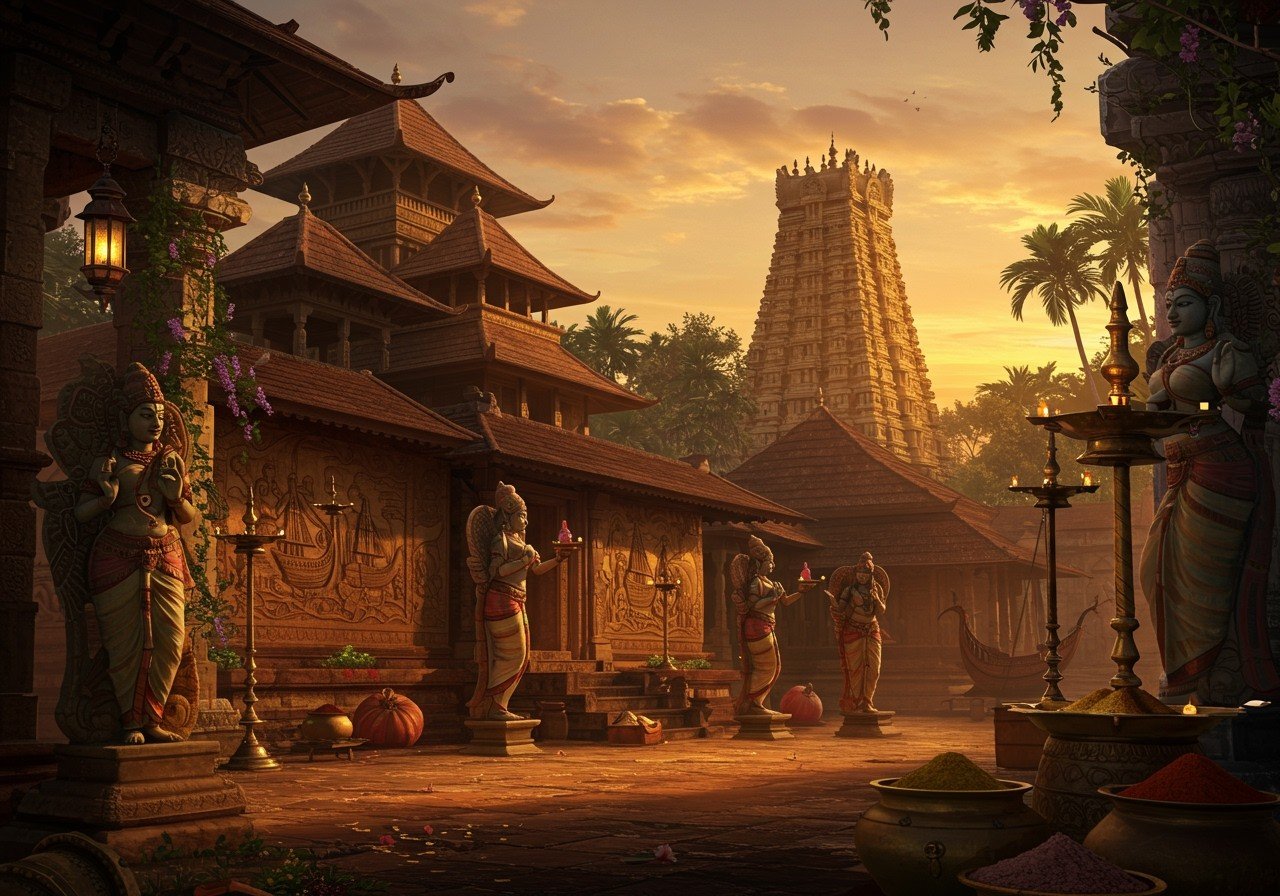
The Chera Dynasty, a prominent ancient Tamil dynasty of South India, reigned from around the 4th century BCE to the 12th century CE, leaving an enduring legacy in art, architecture, and literature. Their influence continues to resonate in modern times, shaping the cultural landscape of the region.
Chera Dynasty Architecture: A Unique Dravidian Style
Chera rulers fostered unique architectural styles, blending local traditions with influences from neighboring regions. Their temples, known for their distinctive Dravidian features, showcase intricate carvings and monumental gopurams. They were known for their Dravidian architecture, particularly their temples dedicated to Lord Shiva.
Notable examples include:
- Thirunelli Temple in Kerala: This temple exemplifies exemplary stonework and features ancient inscriptions, offering a glimpse into the Chera’s mastery of construction and their reverence for detail.
- Kannur Fort (St. Angelo Fort): Originally built during the Chera period, this fort exemplifies military architecture with its robust construction and strategic location, underscoring the dynasty’s focus on defense and power.
- Koyikkal Palace: This palace represents a blend of residential and ceremonial architecture, designed to showcase royal grandeur and the Chera’s sophisticated understanding of design and aesthetics.
The Cheras utilized local materials like granite and laterite, demonstrating their command over natural resources. Temple tank architecture, such as that seen in the Ananthapura Lake Temple, highlights their advanced knowledge of water management systems.
The development of urban planning principles in Chera cities set a precedent for future South Indian dynasties, influencing the layout and organization of urban spaces for centuries to come.
Chera Dynasty Literature: The Flourishing of Tamil Poetry
The Chera Dynasty’s patronage nurtured the flourishing of Tamil literature, especially during the Sangam period (roughly between the 4th century BCE and the 3rd century CE). The Sangam literature, a collection of ancient Tamil poems, offers valuable insights into the social, political, and cultural life of the era.
Noteworthy contributions include:
- Poet Ilango Adigal: Author of the epic ‘Silappatikaram,’ Ilango Adigal received support from Chera rulers, demonstrating the dynasty’s commitment to the arts and the preservation of cultural narratives.
- Pathitrupathu: This collection of poems praises Chera kings, highlighting their valor and benevolence, offering a window into the values and ideals of the Chera rulers.
- Influence of Jainism and Buddhism: The influence of these religions is evident in the religious and philosophical themes explored in the period’s literature, demonstrating a rich tapestry of religious and intellectual thought.
Chera contributions extended to Tamil grammar and lexicon, with scholars like Tholkappiyar laying the groundwork for classical Tamil studies. Literary festivals and assemblies organized by the Chera court fostered poetic excellence and intellectual exchange, creating a vibrant cultural environment.
Chera Dynasty Monuments: Architectural Splendor
The Chera Dynasty’s architectural legacy endures in numerous impressive monuments across South India.
Vadakkunnathan Temple in Thrissur:
A prime example of Chera-period architecture, this temple showcases intricate carvings and a unique structure dedicated to Lord Shiva.
Ancient Port City of Muziris:
Muziris served as a bustling trade hub, revealing the Cheras’ maritime prowess and cosmopolitan connections. Archaeological findings reveal insights into their economic strength.
Edakkal Caves:
These caves feature petroglyphs and murals from prehistoric times, offering a glimpse into the artistic skills and daily life of people during the Chera period.
Mahadeva Temple at Koodalmanikyam:
Associated with King Kulasekhara Alvar, this temple dedicated to Lord Bharata highlights the Cheras’ devotion to Hindu deities and their architectural capabilities.
Bekal Fort:
This fort symbolizes the Chera’s strategic military architecture, showcasing their military ingenuity and focus on territorial defense.
Ongoing preservation efforts by heritage organizations underscore the enduring importance of the Chera architectural heritage.
How Poojn.in Connects You to Chera Dynasty’s Cultural Heritage
Poojn.in offers authentic ritual items that link you to the rich cultural heritage of the Chera Dynasty. Our curated collection includes:
- Traditional Brass Lamps (Vilakku): Mirroring the style found in ancient Chera temples, particularly the intricate Kerala-style nilavilakku, these lamps illuminate the connection to the past. Explore our collection of traditional lamps.
- Temple Worship Items: We offer pure copper and brass items like decorated kalash sets, Kerala-style deepam stands, and ritual bells with classical motifs, echoing the items used in historical Chera temples. Discover our range of temple worship items.
Conclusion: The Chera Dynasty’s Enduring Legacy
The Chera Dynasty’s profound impact on art, architecture, and literature continues to inspire. Their monuments stand as testaments to their cultural and religious contributions. Preservation efforts ensure that their legacy endures, educating and enriching future generations. Exploring these historical sites offers a captivating journey into a vibrant chapter of India’s history.


